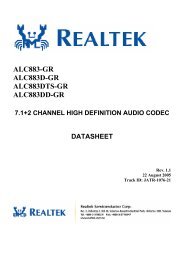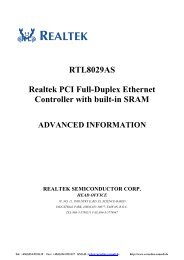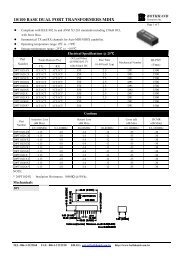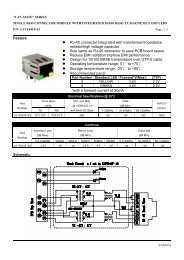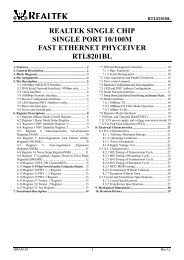realtek single chip single port 10/100m fast ... - Cornelius-Consult
realtek single chip single port 10/100m fast ... - Cornelius-Consult
realtek single chip single port 10/100m fast ... - Cornelius-Consult
Create successful ePaper yourself
Turn your PDF publications into a flip-book with our unique Google optimized e-Paper software.
RTL8201CL<br />
7.8.3 <strong>10</strong>Base Tx/Rx<br />
1) <strong>10</strong>Base Transmit Function: The <strong>10</strong>Base transmit function is performed as follows: The transmit 4 bits<br />
nibbles(TXD[0:3]) clocked in 2.5MHz(TXC) is first feed to parallel to serial converter, then put the <strong>10</strong>Mbps NRZ<br />
signal to Manchester coding. The Manchester encoder converts the <strong>10</strong> Mbps NRZ data into a Manchester<br />
Encoded data stream for the TP transmitter and adds a start of idle pulse (SOI) at the end of the packet as<br />
specified in IEEE 802.3. Then, the encoded data stream is shaped by band- limited filter embedded in<br />
RTL8201CL and then transmitted to TP line.<br />
2) <strong>10</strong>Base Receive function: The <strong>10</strong>Base receive function is performed as follows: In <strong>10</strong>Base receive mode,<br />
The Manchester decoder in RTL8201CL converts the Manchester encoded data stream from the TP receiver<br />
into NRZ data by decoding the data and stripping off the SOI pulse. Then, the serial NRZ data stream is<br />
converted to parallel 4 bit nibble signal(RXD[0:3]).<br />
7.9 Repeater Mode Operation<br />
Setting bit 15 of register 17 to 1 or pulling the RPTR pin high will set the RTL8201CL into repeater mode. In<br />
repeater mode, the RTL8201CL will assert CRS high only when receiving a packet. In NIC mode, the RTL8201CL<br />
will assert CRS high both in transmitting and receiving packets. If using the RTL8201CL in a repeater, please set<br />
the RTL8201CL to Repeater mode, and if using the RTL8201CL in a NIC or switch application, please set the<br />
default mode. NIC/Switch mode is the default setting and has the RPTR pin pulled low or bit 15 of register 17 is set<br />
to 0.<br />
7.<strong>10</strong> Reset, and Transmit Bias(RTSET)<br />
The RTL8201CL can be reset by pulling the RESETB pin low for about <strong>10</strong>ms, then pulling the pin high. It can also<br />
be reset by setting bit 15 of register 0 to 1, and then setting it back to 0. Reset will clear the registers and<br />
re-initialize them, and the media interface will first disconnect and restart the auto-negotiation/parallel detection<br />
process.<br />
The RTSET pin must be pulled low by a 5.9KΩ resister with 1% accuracy to establish an accurate transmit bias,<br />
this will affect the signal quality of the transmit waveform. Keep the circuitry away from other clock traces or<br />
transmit/receive paths to avoid signal interference.<br />
7.11 3.3V power supply and voltage conversion circuit<br />
RTL8201CL is fabricated in 0.18um process. The core circuit needs to be powered by 1.8V , however, the circuit of<br />
digital IO and DAC need 3.3V power supply. RTL8201CL has embedded a regulator to convert 3.3V to 1.8V. Just<br />
like many commercial voltage conversion devices, the 1.8V output pin (PWFBOUT) of this circuit requires the use<br />
of an output capacitor (22uF tantalum capacitor) as part of the device frequency compensation and another small<br />
capacitor (0.1uF) for high frequency noise de-coupling. And PWFBIN is fed with the 1.8V power externally from<br />
PWFBOUT through a ferrite bead as below figure shown. Strongly emphasize here, do not provide any extra<br />
external 1.8V produced by any other power device other than PWFBOUT and PWFBIN.<br />
The analog and digital Ground planes should be as large and intact as possible. If the ground plane is large<br />
enough, the analog and digital grounds can be separated, which is a more ideal configuration. However, if the total<br />
ground plane is not sufficiently large, partition of the ground plane is not a good idea. In this case, all the ground<br />
pins can be connected together to a larger <strong>single</strong> and intact ground plane.<br />
2002-03-29 20<br />
Rev.1.0<br />
Tel: +49(0)234-9351135 · Fax: +49(0)234-9351137 E-MAIL: info@cornelius-consult.de http://www.cornelius-consult.de



